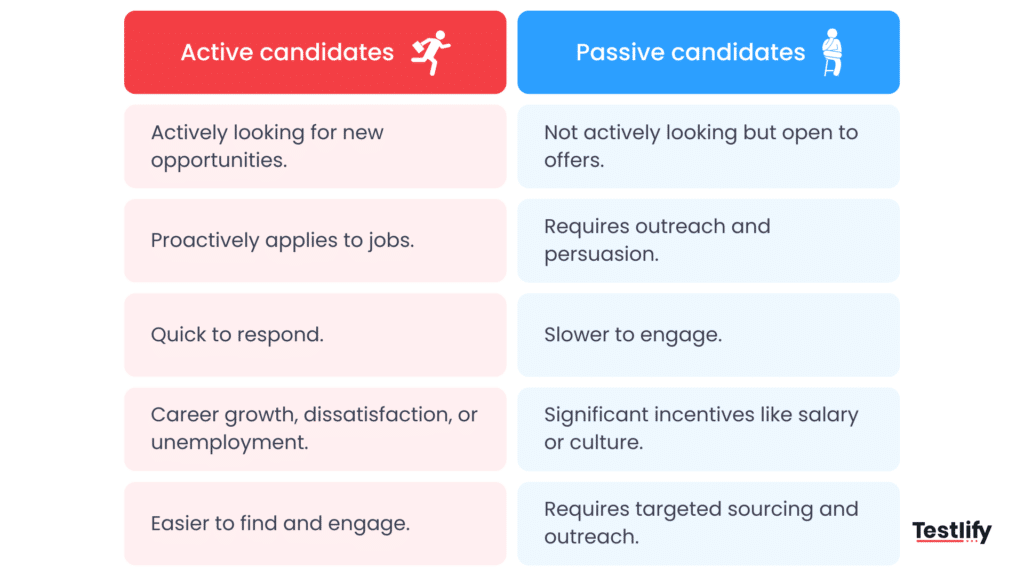Right talent is the most important aspect for the growth and success of any organization. However, the approach to recruitment has evolved, and one important category that HR professionals need to focus on is “active candidates.” Knowing who active candidates are, how to engage with them, and how to successfully recruit them can give your organization a great advantage.
A report by SHRM suggests, While 73% of potential candidates are passive job seekers, 87% of them are open to new job opportunities offered through active recruitment.
In this blog, let’s see active candidates in all their forms—what they are, how you identify them, and how to develop strategies to get the best of them in your company.
What are active candidates?
Active candidates are those who are actively searching for a new job opportunity. Unlike passive candidates, who are not actively looking for a job but may be open to offers, active candidates have decided to pursue new employment and are actively applying for roles.
According to Deloitte, 77% of employers globally report difficulty finding the skilled talent they need, highlighting the importance of engaging both active and passive candidates.
Active job seekers are normally found on job boards and networking events and apply directly to companies they are interested in. They might also be seeking recruiters or staffing agencies for assistance with their job hunt.
Key characteristics of active candidates
- Job-seeking behavior: Active candidates actively apply to positions, attend interviews, and pursue leads. They have a visible presence in the job market.
- Motivation to change: These candidates are looking for a new job for various reasons—personal growth, better compensation, a new challenge, or even dissatisfaction with their current employer.
- Availability: Active candidates are generally available to start a new job soon, as they are looking for immediate opportunities.
- Commitment to finding a job: They are more likely to dedicate time to researching and applying for jobs, attending interviews, and negotiating offers.
The role of recruiters in attracting active candidates
This function of recruiters is critical in identifying, engaging, and retaining active candidates. Here is how the recruiters can support the HR teams in hiring the best active candidates:
Building relationships
Recruiters should also cultivate a long-term relationship with active candidates even before jobs are available. This results in a pipeline of good-quality candidates who will look for opportunities when they need them.
Talent pool development
The department also grooms the talent pool of the HR team by tracking those who are qualified and best suited for positions in the future. With an active list of candidates, it will facilitate smooth hiring and shorten the time to fill in subsequent vacancies.
Managing expectations
Recruiters can work with the candidate and employer to help ensure mutual satisfaction. They work to negotiate the compensation terms, answer all their queries, and ensure the smooth progression of an active candidate in the selection process.
How to spot active candidates?
Spotting active job seekers is critical to properly targeting your recruitment efforts. These people tend to provide clear signals through updating LinkedIn profiles, actively participating in professional groups, or even applying to roles quite frequently. Being able to recognize such signals helps you prioritize your outreach efforts.
Monitor job boards and career websites
Job boards are the most significant sources for the search for active candidates. It can be found that there are ample numbers of active candidates on websites like LinkedIn, Indeed, Glassdoor, and any industry-specific job board. Hence, keeping an eye on such boards can help HR identify active candidates who suit their hiring needs.
Review online portfolios and personal websites
Many active candidates, especially in the creative or technical fields, have personal websites or online portfolios they use to showcase work. You can then use those resources to find someone with the right skillset looking for a job. This proves especially useful for niche roles, where active candidates likely are not using traditional boards.
Leverage social media platforms
LinkedIn and other social media are good sources for finding active candidates. On LinkedIn, users can specify that they are “open to new opportunities,” most applicants use the platform to search for job openings, connect with potential employers, and build their professional networks. Through LinkedIn’s job posting and recruiting features, HR professionals can find those individuals actively looking for a new role.
Use recruitment software
This way, modern recruitment tools and ATS can help HR professionals identify active candidates who have not applied for several positions or consistently inquired about jobs. This is because they track the activity of candidates, thereby giving HR teams real-time insights into the engagement of candidates and their status.
Where to find active candidates?
Speeding up hiring can be possible through active candidate finders. Some efficient mediums for finding active candidates and websites include:

Job boards
Active candidates may spend time on job boards such as LinkedIn, Indeed, Glassdoor, and similar websites. They provide free space to post job openings and can directly interact with interested job seekers.
Social media
This list will spot such networks where active candidates are not just maintaining their professional presence but also posting job openings and getting in touch with seekers seeking fresh opportunities. Other online means that can give some perception are the Twitter and Facebook platforms on which people actively chatter while trying to find new engagements.
Company website career pages
Active candidates will apply through the career section on your company’s website. Moreover, an attractive and friendly job portal will attract an active candidate looking to change his job.
Recruitment agencies
Staffing agencies often have a specialized niche in finding active candidates, often specific to a particular industry or skill set. They can become a crucial business partner in rapidly sourcing the right active candidate.
Networking events and career fairs
Job fairs, industry-specific conferences, and other networking events are good for in-person meetings active candidates. Such events attract job applicants looking for new opportunities, and you can get in touch directly with the best talent through these events.
Strategy for recruiting active candidates
Active candidates should be approached in a customized way to attract and engage. Here’s how to create a strategy that will resonate with active job seekers:
1. Create clear and engaging job descriptions
It will attract any active candidate if it does not taking more than a glance or few seconds to review, so the job posting description should be simple, clear, and encouraging. Highlight the job-related responsibilities, skills that a human being needs to carry it forward, and what that job holds within the company’s culture. Career development, work-life balance, and any perks of work that make your organization exclusive will be great while presenting.
2. Leverage recruitment marketing
An active candidate is looking for a suitable opportunity in a position that best fits their career goals. Recruitment marketing will bring the right candidate to your organization. Showcase the company culture, success stories, and benefits of working with your team. Share employee testimonials, blog posts, or videos on what it’s like to work at your company.
3. Engage quickly and personally
Candidates in action have several positions in mind. Hence it will be best to contact early to avoid missing this opportunity. A personalized mail or call by your company would be something to look up to. You can tell them specifics from their resumes or portfolio to show the concern taken and why they’ll make a perfect fit for this open position.
4. Speed up the hiring process
Active applicants are motivated by efficiency. So if recruitment takes too long or is too time-consuming, the employer will end up frustrated and losing great talent. Make the whole process of interviewing and getting decisions to keep the applicants engaged. If they like how your company treats them with respect towards their time, they’ll maintain interest.
5. Offer competitive salaries and benefits
Active job seekers often look for betterment in the financial and professional status in their lives. To attract the best, make your compensation packages competitive in industry standards. Let the benefits, compensation, and anything else that the organization would offer be open.
6. Use technology and automation
Recruitment technology, such as an ATS, may be more practical in organizing, tracking, and communicating with active candidates. Other automation tools are used to schedule interviews or send reminders for follow-up emails for candidates.
Active candidate vs passive candidate: Key differences
The basic difference between active and passive candidates can be determined by their current status about the job search. To illustrate, here’s a brief comparison:

Active candidates
- Actively job hunting, frequently applying to job openings, and available for interviews.
- They are usually more responsive and quicker to make decisions.
Passive candidates
- Not currently looking for a new job but might be open to offers.
- Recruiting passive candidates takes more time and effort, as you need to build a relationship and demonstrate the benefits of a career move.
Understanding this difference helps HR teams create tailored strategies for attracting and engaging each type of candidate.
How to retain active candidates after they accept an offer
Securing an active candidate is half the battle; retaining him or her post-offer is equally crucial. This involves a smooth onboarding process, regular communication, and delivery of promises made during recruitment. A strong retention strategy builds trust and ensures long-term employee satisfaction.
Onboarding process
Once you’ve successfully hired an active candidate, the next step is to ensure they transition smoothly into their new role. A well-organized and welcoming onboarding process can help new hires feel comfortable and excited about joining the team. Offer clear instructions, provide the necessary tools, and introduce them to key colleagues.
Set expectations early
Setting clear expectations about the role, performance, and growth opportunities is important for your active candidates to be interested and satisfied in the new position. Regular check-ins and feedback will keep them motivated and aligned with your organization’s goals.
Encourage career development
One of the main reasons many active candidates seek a new job is career growth. You can help retain your new hires and keep them motivated in the long term by providing continuous learning opportunities, mentorship programs, and paths for promotion.
Conclusion
Attracting and hiring active candidates is essential. Understanding who active candidates are, how to engage with them, and how to create a positive recruitment experience will help HR professionals find and retain top talent quickly and effectively.
By implementing the approaches recommended, you will be able to construct an active approach to talent acquisition, ensuring a streamlined recruitment process that works in favor of your company and the candidates whom you hire. You will be able to position your organization as an employer of choice in a crowded job market by recognizing the needs and desires of active candidates and responding to them with speed, personalization, and transparency.
Having considered active candidates, your business will be able to secure the best and retain talent in a continued quest to prosper.









